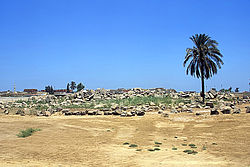Behbeit El Hagar
Behbeit El Hegara
بهبيت الحجارة | |
|---|---|
 View of the temple site | |
| Coordinates: 31°01′40″N 31°17′15″E / 31.02778°N 31.28750°E | |
| Country | |
| Governorate | Gharbia |
| Time zone | UTC+2 (EST) |
Behbeit El Hagar (Ancient Egyptian: Pr-ḥꜣbyt(.t), lit. 'house of festival hall', Coptic: ⲡⲁϩⲃⲉⲓⲑⲓⲟⲥ, Ancient Greek: Πααβηιθις[1]) is a village and an archaeological site in Lower Egypt that contains the remains of an ancient Egyptian temple to the goddess Isis, known as the Iseion. The village and the site lie in Gharbia Governorate along the Damietta branch of the Nile, 7 kilometers (4.5 mi) northeast of Sebennytos[2] and 8 kilometers (5 mi) west of Mansoura.[3] In ancient times it was part of the nome of Sebennytos,[4] the Twelfth Lower Egyptian Nome.[5] Ancient Egyptian texts refer to the site as early as the New Kingdom (c. 1550–1070 BC), but it may have been simply an offshoot of Sebennytos rather than a full-fledged town.[2]
Sources as early as the Pyramid Texts, in the Fifth Dynasty indicate that Isis was connected with the region of Sebennytos, and she and her cult may have originated there.[4] However, major temples were not dedicated to her until the Thirtieth Dynasty, when her temples at Philae and at Behbeit El Hagar began construction.[6] The two temples paralleled each other, with Philae serving as Isis's main cult center in Upper Egypt and Behbeit El Hagar as its Lower Egyptian counterpart.[3]
The Iseion was begun in the reign of Nectanebo II (360–342 BC) and completed in the reign of Ptolemy III (r. 246–222 BC).[6] Whereas most Egyptian temples were built primarily of limestone or sandstone, with harder stones such as granite used only for individual elements such as statues, obelisks, or doorways, the temple at Behbeit El Hagar was built entirely of granite. The temple was demolished at some point, possibly in ancient times, by an earthquake or by the removal of its stone to serve as building material. Only scattered blocks remain there today.[7]
|
|
|
See also
[edit]- List of ancient Egyptian sites, including sites of temples
References
[edit]- ^ Peust, Carsten. "Die Toponyme vorarabischen Ursprungs im modernen Ägypten" (PDF). p. 18.
- ^ a b Snape, Steven (2014). The Complete Cities of Ancient Egypt. Thames & Hudson. p. 195
- ^ a b Wilkinson, Richard H. (2000). The Complete Temples of Ancient Egypt. Thames & Hudson. p. 104
- ^ a b Münster, Maria (1968). Untersuchungen zur Göttin Isis vom Alten Reich bis zum Ende des Neuen Reiches (in German). Verlag Bruno Hessling. p. 158
- ^ Wilkinson, Richard H. (2003). The Complete Gods and Goddesses of Ancient Egypt. Thames & Hudson. p. 87
- ^ a b Wilkinson, Richard H. (2003). The Complete Gods and Goddesses of Ancient Egypt. Thames & Hudson. p. 149
- ^ Wilkinson, Richard H. (2000). The Complete Temples of Ancient Egypt. Thames & Hudson. pp. 40–41, 104–105
- ^ a b Gauthier, Henri (1925). Dictionnaire des Noms Géographiques Contenus dans les Textes Hiéroglyphiques Vol. 2. pp. 110-111.
- ^ Wallis Budge, E. A. (1920). An Egyptian hieroglyphic dictionary: with an index of English words, king list and geological list with indexes, list of hieroglyphic characters, coptic and semitic alphabets, etc. Vol II. John Murray. p. 1021.
- ^ Gauthier, Henri (1927). Dictionnaire des Noms Géographiques Contenus dans les Textes Hiéroglyphiques Vol. 4. p. 24.
Further reading
[edit]- Favard-Meeks, Christine (1991). Le temple de Behbeit el-Hagara. Essai de reconstitution et d'interprétation. Buske Verlag.
- Favard-Meeks, Christine (2016). Behbeit el-Hagara web site Archived 2018-09-13 at the Wayback Machine
- Münster, Maria (1968). Untersuchungen zur Göttin Isis vom Alten Reich bis zum Ende des Neuen Reiches (in German). Verlag Bruno Hessling. OCLC 925981274.
External links
[edit]![]() Media related to Behbeit el-Hagar at Wikimedia Commons
Media related to Behbeit el-Hagar at Wikimedia Commons

